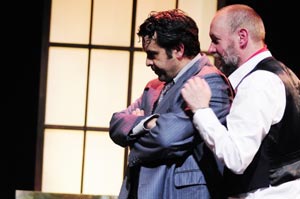| Witty and Deft New Writing |
Wales at Edinburgh Fringe |
| Equinox Theatre- Supertramp, Sickert and Jack the Ripper , Venue 13 Edinburgh Fringe , August 20, 2010 |
 GUIDES TO THE SEQUENCE “WALES AT EDINBURGH FRINGE” CAN BE READ BELOW 11TH AND 18TH AUGUST 2022
GUIDES TO THE SEQUENCE “WALES AT EDINBURGH FRINGE” CAN BE READ BELOW 11TH AND 18TH AUGUST 2022The Supertramp is Newport-born, one-legged hobo and literary celebrity W H Davies. Actor Chris, in a play within a play, wants him for a dramatic subject. “Any money in it?” asks writer Lewis (Richard Tunley) in a rich Cwmbran accent. “Nothing” is the inevitable reply. Lewis is down on his luck, suffering relationship angst and sexual starvation. As for his writing career “the Court is going to get back to him” and he is in contact with “Alison from the BBC.” Chris meanwhile wants a play about “life and art, a fractal comment on contemporary society.” It does not matter too much how or even whether Davies and Walter Sickert met. As Chris says, Alan Bennett has shoved W H Auden and Benjamin Britten together for the sake of a play and they barely met. The acting in Lewis Davies’ two-hander sparkles from line one. Edinburgh is a try-out for all talents and the acting can be variable. Chris Morgan speaks a line of eighteen syllables on one effortless single breath and it is a reminder of the craft of the accomplished actor. When Richard Tunley makes his first entry as a stiff-legged Davies he takes on the accent of a comic Oscar Wilde. A plot like this runs the danger of collapsing inward on its own references. But Lewis Davies has achieved in his writing a light musicality in which motifs and riffs occur and re-occur. Sickert claims he wants an art dealing with “gross material facts” yet he has a distaste for “close up wetness and the sharing of fluids.” He amends the title of his famous canvas from “What we shall we do about the rent?” to “the Camden Town Murder.” The work itself does not change but the words chosen to describe it change the interpretation completely. The image in paint, pure material substance, is subordinate to language, which is pure concept. Out in the “real” world Chris views Davies less as a Romantic Georgian than as a forerunner of the Beat Generation. It is the writer who provides the bracing offset of reality. Davies has similes to hand like “cold as a well-digger's arse” and describes a hideous lynching in Louisiana. He is suspicious of artistic individuality over-riding tradition. Will it be “a proper portrait?” he asks. On being assured it will he presses the point “But will it look like me?” But unlike Sickert, who in youth was bewitched by theatre, Davies early on saw through the false claims of authority in a youthful episode involving a tipped-over gravestone. Sickert’s Mornington Crescent Studio is simply but effectively rendered in Cordelia Ashwell's design. The opening scene necessarily involves some exposition. The timing and cross-rhythms of the lines are beautifully modulated. Rebecca Gould is that model of directors, totally present while completely invisible. “What about the ending?” asks Chris of his writer. “I shall write it when I get to it” is the reply. Lewis Davies provides a fine last line but it does arrive as a jolt. How true it is to Sickert's aesthetic I am not so sure, questionable when applied to a wonderful image like his Minnie Cunningham. There are some truly heavy-going items on at the Fringe. Lewis Davies’ play is a sharp corrective, a zesty, refreshing sorbet of a show. Paul Theroux once signed off a travel piece with the line “It raised my heart.” “Supertramp, Sickert and Jack the Ripper” did the same for mine. |
Reviewed by: Adam Somerset |
This review has been read 7307 times There are 97 other reviews of productions with this title in our database:
|
